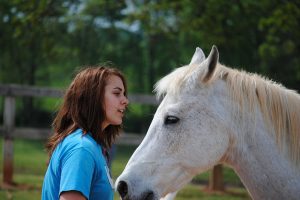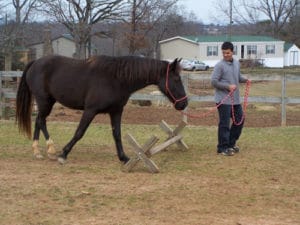At Shepherd’s Hill Academy, we understand the challenges you’re experiencing as parents working diligently to raise your children in today’s world. We know the frustration and hopelessness that can come with a child’s struggles – but we also know there is hope. Through Equine Relationship Therapy (ERT), children can find healing, and families can have their joy and purpose restored.
Equine Relationship Therapy, or ERT, is an important therapeutic component of the year-long residential program at Shepherd’s Hill Academy. Students work one-on-one with a horse of their choosing, achieving relationship and horsemanship goals throughout the course of their year. Each horse is as unique as the student who chooses it, allowing the student to gain important life skills and lessons from the immersive, hands-on experience.
The Equine Relationship Therapy Model
The ERT program at SHA is led by our Equine Program Director and Therapist. She and our Horse Professional combine therapeutic modalities with horsemanship through our exclusive equine relationship therapy program developed at Shepherd’s Hill Academy. Through a student reflection notebook called Stable Eyes, each child will have a unique record of their own personal progress, growth, challenges, and efforts.
The ERT model features 4 Stages of Progress that track how a student progresses through the program during their time at Shepherd’s Hill Academy. Each stage requires students to develop both relationship skills and horsemanship skills.
Stage 1: Acquaintance
 Developing a relationship with a horse is like building a relationship with another person. Horses are incredibly perceptive, challenging students to truly invest in their relationships. The process of building a relationship with their horse also challenges students to become more self-aware and aware of the feelings and reactions of others.
Developing a relationship with a horse is like building a relationship with another person. Horses are incredibly perceptive, challenging students to truly invest in their relationships. The process of building a relationship with their horse also challenges students to become more self-aware and aware of the feelings and reactions of others.
The Acquaintance Stage helps to enhance therapeutic progress in relationships by focusing on the relational skills of responsibility, situational awareness, communicating healthy boundaries, follow through, self-control, leadership, respect, encouraging others, trust, listening, communication, patience and problem solving.
In this first stage, students new to Shepherd’s Hill Academy will:
- Introduce themselves to the horse
- Learn more about the horse they have chosen
- Distinguish their horse from others
- Develop a deeper understanding of their horse’s temperament and character
The first thing the student learns to do when introducing themselves to their horse is catch and halter their horse. To halter their horse, the student must establish trust with that horse. Otherwise, the horse may resist or move away from the student.
The establishment of trust is also transferred to human interactions as the student learns how to build healthy foundations for real-life relationships.
This process continues to build strong interpersonal relationship skills. Students will also feel a strong sense of accomplishment when they have completed this first skill, promoting a positive sense of awareness and joy in developing healthy relationships.
Next, the student will learn to lead their horse. This component provides therapeutic value as the student learns that leading and controlling are two very different things. They also begin to feel the difference between willing engagement and appeasement from the horse.
They will also progress to refining communication through:
- Use pressure/release
- Further develop their relationship by building trust with their horse
- Asking the horse to follow them willingly; with and without a halter
- Asking the horse to go over, under, around or through obstacles willingly with and without a halter on.
There are a lot of boundaries taught at this stage. The horses must know where they should be walking with the student, not too close and not too far, and what behaviors are appropriate while on a lead line. This is determined by the student as they make known their preference with a pressure-release form of communication.
Some horses may be timid and afraid, refusing to move or adhere to set boundaries. These horses will require more investment in the relationship; promoting empathy, patience, and trust.
Other horses may be more dominant, providing pushback against command. These horses teach the students that trust must be earned. They also learn the benefits of perseverance and loyalty.
Stage 2: Friendship
During the friendship stage of equine therapy, the student begins to work towards the mutual emotional relational benefits of physically getting on the horse. The Friendship stage enhances therapeutic progress by focusing on relationship skills such as planning ahead, taking positive healthy risks, exercising faith, showing compassion, relaxing in relationship, empathy and critical thinking.
During the friendship stage, students will learn to mount and perform an emergency dismount by practicing on a dummy horse. Then they will test their friendship by asking the horse to line up along the fence line or mounting block without a halter on. This allows the horse to exercise its own free will to be ridden or not.
Once the horse willingly stays in position to be mounted, the student eases into the higher position. First, the student pets the horse’s back and progressively becomes more connected without mounting for the first few times.
Then the student pets the horse all over from above the horse (from mounting position). The student can lean over the horse and relax their legs on the horse’s back from the fence while the horse is still un-haltered.
These exercises grow the trust necessary for a prey animal to be willing to let a predator on its back. This process is intentional, allowing the student to understand the free will of the horse and the value of positive relationships based on trust. Students are prepared with helmets nearby during the advanced part of this stage, allowing them to be fully prepared should the horse allow them to mount.
Stage 3: Forming a Partnership
This stage begins after the first mount. It includes learning proper set up and preparation in tack (bareback pads and side pull) for riding and steering. The Partnership stage helps to enhance therapeutic progress by focusing on relationship skills such as critical thinking, confidence, fine tuning communication, good planning, patience, mindfulness, self-sacrifice, encouragement.
The student and the horse begin to work together in a partnership to achieve goals. As the student grows in their partnership with the horse, they can communicate from a different position. They also work on successfully directing the horse over, under, around or through obstacles while riding.
This stage helps develop balance and proprioception skills. The students work on developing empathy, leadership and how to cope with rejection as they work to build the trust needed to mount the horse.
Stage 4: A Stable Relationship
The final stage, The Stable Relationship stage, helps to enhance relationship skill progress by focusing on self-awareness/regulation, follow through, connecting emotionally and allowing for positive change in self.
During this stage of the equine therapy process, students are trained in natural horsemanship which further enhances communication and leadership skills. They will also set their own riding goals under the supervision of equine staff. Here they continue to grow and expand their skills and abilities in horsemanship and leadership.
Students are riding the horses with bareback pads. These pads allow the student to feel the motion of the horse and to synchronize with their movement. This rhythmic movement also works to increase muscle strength, posture and coordination while reducing stress.
Students will ride their horses to the movement of music including soundtracks and worship style music. Using the rhythm of the music, the students can get in sync with their horse’s body and therefore engage in even more experiences that promote neurodevelopment and good proprioception for the student.



